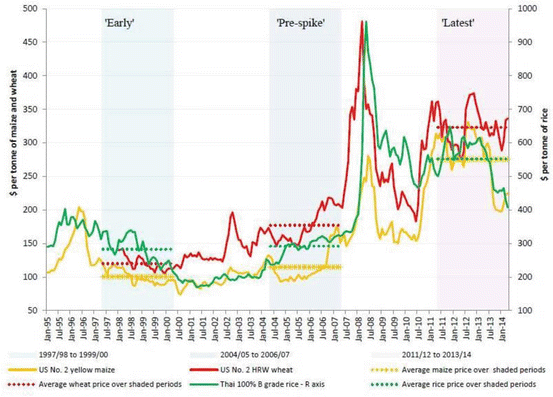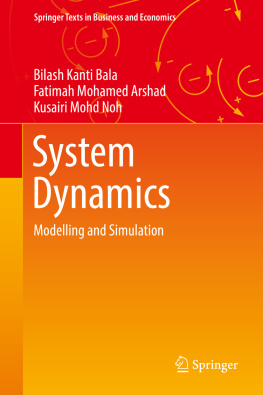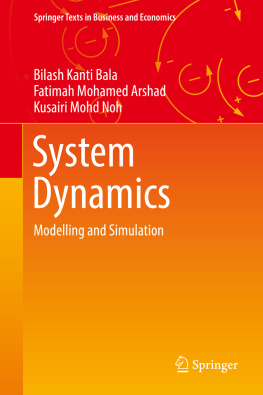Springer Science+Business Media Singapore 2017
Bilash Kanti Bala , Fatimah Mohamed Arshad and Kusairi Mohd Noh System Dynamics Springer Texts in Business and Economics 10.1007/978-981-10-2045-2_1
1. Introduction
Bilash Kanti Bala 1, Fatimah Mohamed Arshad 1 and Kusairi Mohd Noh 1
(1)
University Putra Malaysia, Serdang, Selangor, Darul Ehsan, Malaysia
This chapter introduces the complexity and change of the dynamic systems, systems thinking and system dynamics as a methodology of systems thinking. Feedback system concepts and mode of behaviour of dynamic systems are highlighted. Model and simulation are defined, systems thinking methodology outlined and usefulness of models are discussed.
1.1 Introduction to Complexity and Change of the Dynamic Systems
We live in a complex world, and it is always at a change. Also we are confronted with complex agricultural, biological, aquacultural, environmental, technological and socio-economic problems which we need to understand and manage for sustainable development. In global context we debate seriously on global warming and its impacts on agriculture, energy and environment and also find reports on economic cycles causing financial panics, and in regional and local levels, we often find price fluctuations and food insecurity in the developing countries to mention some of the problems of complex and dynamic systems. Figure ). System dynamics methodology based on feedback concepts to handle non-linearity, multi-loop and time-lag characteristics of complex dynamic systems can be applied to model and simulate such complex dynamic systems to understand the dynamics of systems and design management policy for sustainable development.
Fig. 1.1
Price fluctuations of wheat, maize and rice in the international market (Steve and Sharada )
Indeed, we can understand and design management strategies, but we need some structures or guiding principles to understand and manage the complexity and changes of complex dynamic systems based on systems approach which considers the whole systems rather than in isolation. Systems approach is rather a rational rather intuitive approach. It depends on some formalised methodology consisting of methods of problem definition, dynamic hypothesis, modelling, policy analysis, etc., and theoretical techniques which are useful for solving models and sub-models of the problem. In essence the systems must be modelled and simulated to understand the systems and design management strategies. Also these must be done before implementation of the management strategies. Forresters system dynamics methodology provides the methodologythe guiding principles to develop computer models to simulate such complex and dynamic systems to understand the complex systems and design the management strategies. In essence, systems thinking is a formalised methodology consisting of methods of problem definition, dynamic hypothesis, modelling and policy analysis to understand and manage complex and dynamic systems.
As the complexity of our world increases, systems thinking is emerging as a critical factor for success, and even survival. How then can people become skilled systems thinkers? But in the world of complex dynamic systems, everyday experience fails because the time horizon and scope of the systems are so vastwe never experience the majority of the effects of our decisions. When experiments in the real world are impossible, simulation becomes the main way we can learn effectively about the dynamics of complex systems. System dynamics is the most appropriate technique to simulate complex and dynamic systems based on systems thinking to develop policy scenarios and learn to effectively manage the systems.
1.2 Concepts of Systems and System Dynamics
System dynamics is a methodology based on feedback systems borrowed from control theory, and it can handle easily the non-linearity and time-delay and the multi-loop structures of the complex and dynamic systems. Forresters methodology provides a foundation for constructing computer models to do what the human mind cannot dorationally analyse the structure, interactions and modes of behaviour of complex social systems, thus providing a framework whereby strategies can be tested and trade-offs can be performed, while options are still open. Many software such as STELLA, VENSIM, and POWERSIM are nowadays available which have revolutionised the system dynamics modelling. Furthermore, these software are icon operated and allow us to model virtually any process or system.
1.3 Open and Feedback Systems
We have discussed about some complex and dynamic systems in Sect.. What is meant by a system? Here system means a grouping of parts that operate together for a common purpose. For a simple example, a tractor is a system of components that work together for providing cultivation. A system may include people as well as physical parts. A family is a system for living and raising children. Systems may include biological as well as economic components, and such systems are known as bioeconomic systems. Agricultural and aquacultural systems are examples of bioeconomic systems. Crop irrigation system is an example of an agricultural system, while prawn production system is an example of aquacultural system. Also price forecasting is an economic system. In aquacultural system aquatic animals are raised to maturity in an economic manner. A system may include physical, economic, social, biological, technological and political components, and such a system is highly complex. For example, agricultural production systems with climate change in an agricultural system consists of physical, biological, social, technological, environmental, economic and political components and their interactions.
Systems may be classified as (a) open systems and (b) feedback systems. In open systems the output responds to input, but output has no influence on the input. Also the input is not aware of its own performance. In an open system, past action does not affect the future action. For example, a watch is not aware of its inaccuracy and does not correct the time itself. In an open system, the problem is perceived and action is taken, but the result does not influence action (Fig. ). When the hand valve is opened, water starts flowing in the tank and the water level in the tank continues to increase until the hand valve is closed by the user who is not part of the system.
Fig. 1.2
Open system concept
Fig. 1.3
Filling up a water tank without control of the valve
Feedback systems are closed loop systems, and the inputs are changed on the basis of output. A feedback system has a closed loop structure that brings back the results of the past action to control the future action. In a closed system, the problem is perceived, action is taken and the result influences the further action (Fig. ). Thus, the distinguishing feature of a closed loop system is a feedback path of information, decision and action connecting the output to input.











![Bimal Kanti Paul - Natural Hazards and Disasters: From Avalanches and Climate Change to Water Spouts and Wildfires Vol 1 [2 Volumes]](/uploads/posts/book/258477/thumbs/bimal-kanti-paul-natural-hazards-and-disasters.jpg)





